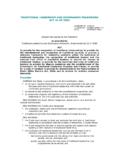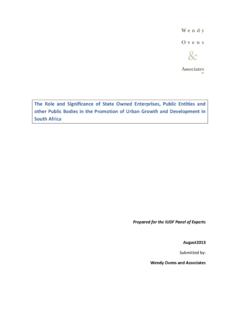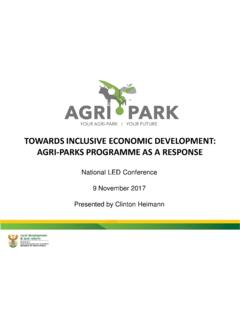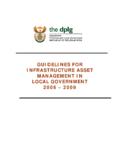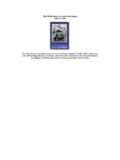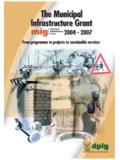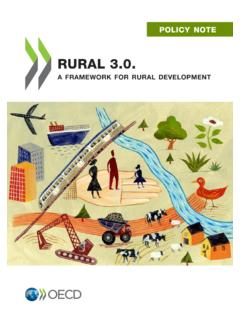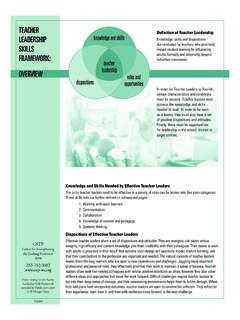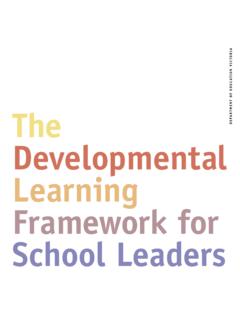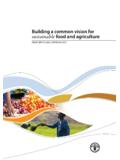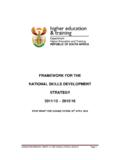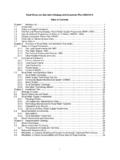Transcription of Integrated Urban - Department of Cooperative …
1 Integrated Urban Development framework DRAFT For Discussion 2 Draft Integrated Urban Development framework TABLE OF CONTENTS. TABLE OF CONTENTS.. 2. list of figures.. 4. ACKNOWLEDGMENTS.. 5. ACRONYMS.. 6. Executive Summary.. 7. Introduction.. 11. SOUTH AFRICA'S Urban REALITY.. 14. Cities and towns shaped by the apartheid legacyv .. 15. Demographic, migration and settlement patterns.. 16. Rural- Urban interdependency.. 17. Disaster risk reduction and climate change.. 20. Urban safety.. 21. The importance of Urban areas in South Africa.. 22. The New Deal: An Integrated Urban Development framework (IUDF).. 28. Vision.. 29. Strategic goals.. 29. Policy levers .. 30. Policy Lever 1: Integrated Spatial Planning.. 32. Status quo .. 33. Challenges.. 34. Policy priorities.. 35. Key actors.. 37. POLICY LEVER 2: Integrated TRANSPORT AND MOBILITY.. 38. Status quo .. 39. Challenges.. 40. Policy priorities.. 41. Key actors.. 43. TABLE OF CONTENTS 3.
2 POLICY LEVER 3: Integrated AND SUSTAINABLE HUMAN SETTLEMENTS.. 44. Status quo .. 45. Challenges.. 46. Policy priorities.. 46. Key actors.. 49. POLICY LEVER 4: Integrated Urban INFRASTRUCTURE.. 52. Status quo .. 53. Challenges.. 54. Policy priorities.. 55. Key actors.. 58. POLICY LEVER 5: efficient LAND GOVERNANCE and management.. 60. Status quo .. 61. Challenges.. 62. Policy priorities.. 63. Key actors.. 65. POLICY LEVER 6: INCLUSIVE ECONOMIC DEVELOPMENT.. 66. Status quo .. 67. Challenges.. 68. Policy priorities.. 69. Key actors.. 73. POLICY LEVER 7: EMPOWERED ACTIVE COMMUNITIES .. 74. Status quo .. 75. Challenges.. 75. Policy priorities.. 76. Key actors.. 79. Policy Lever 8: EFFECTIVE Urban GOVERNANCE .. 80. Status quo .. 81. Challenges.. 81. Policy priorities.. 83. Key actors.. 86. CONCLUSION.. 87. 4 Draft Integrated Urban Development framework list of figures Figure 1: Rural- Urban push and pull factors.. 18. Figure 2: Rural Urban continuum.
3 19. Figure 3: Change in absolute population between 1996 and 2011.. 23. Figure 4: Population and economic activity indicated per type of Urban area.. 24. Figure 5: Individual monthly income per province, 2011.. 25. Figure 6: Optimising the Urban dividend.. 26. Figure 7: Coordinated investment in people and places.. 27. ACKNOWLEDGMENTS 5. ACKNOWLEDGMENTS. The Ministry of Cooperative Governance and Traditional Affairs, as coordinating Department , acknowledges the critical role-players who have contributed to the process to date. Special thanks are given to the IUDF Political Forum and the partners who constituted the core Working Group, which has coordinated the content of the framework : the Department of Human Settlements, the Presidency (National Planning Commission), National Treasury, the South African Local Government Association (SALGA), the South African Cities Network (SACN), and the Deutsche Gesellschaft f r Internationale Zusammenarbeit (GIZ).
4 In addition to the work of the Working Group and the Panel of Experts, the process thus far has also depended on the guidance and contributions of a Technical Steering Committee, which includes the Department of Rural Development and Land Reform, Department of Transport, Department of Environmental Affairs, Department of Water and Sanitation and the Economic Development Department . Economic Development Department Environmental Affairs Finance Human Settlements Rural Development and Land Reform Transport Water and Sanitation 6 Draft Integrated Urban Development framework ACRONYMS. BRT Bus Rapid Transit CSP City Support Programme CWP Community Works Programme DFI Development Finance Institution EPWP Expanded Public Works Programme FBS Free Basic Services FFC Financial and Fiscal Commission GDP Gross Domestic Product GVA Gross Value Added HDA Housing Development Agency HSDG Human Settlements Development Grant ICT Information and Communication Technologies IDP Integrated Development Plan IGR Intergovernmental Relations IPTN Integrated Public Transport Networks IUDF Integrated Urban Development framework JCPSC Justice.
5 Crime Prevention and Security Cluster LED Local Economic Development LGTAS Local Government Turn Around Strategy MTSF Medium Term Strategic framework NDP National Development Plan NDPG Neighbourhood Development Partnership Grant NGO Non-Governmental Organisation NGP New Growth Path NLTA National Land Transport Act NMT Non-Motorised Transport NUSP National Upgrading Support Programme PICC Presidential Infrastructure Coordination Committee PRASA Passenger Rail Agency of South Africa PTISG Public Transport Infrastructure and Systems Grant RDP Reconstruction and Development Programme SALGA South African Local Government Association SDF Spatial Development framework SIP Strategic Integrated Programme SMME Small, Medium and Micro Enterprise SPLUMA Spatial Planning and Land Use Management Act No. 16 of 2013. SOE State-Owned Enterprise TOD Transit-Oriented Development USDG Urban Settlements Development Grant Executive Summary 7. Executive Summary South Africa's cities and towns are shaped by the apartheid legacy of racial segregation, poverty, and exclusion from social and economic opportunities.
6 High levels of inefficiency and wasteful use of scarce resources (especially land and infrastructure networks) characterise the country's cities and towns. Despite significant service delivery and development gains since 1994, these spatial patterns have largely not been reversed. Like most of Africa and other developing countries, South Africa is experiencing continuing urbanisation. The United Nations estimates that of the South African population will live in Urban areas by 2030, reaching nearly 80% by 2050. South Africa's Urban population is growing larger and younger, as individuals and households move into inner-core' cities where jobs are created and household incomes are higher. Nearly two-thirds (64%) of South Africa's youth live in Urban areas, whereas the aged (no longer economically active) population tend to migrate to more rural settlements and secondary cities in other provinces. The Urban centres dominate the country's economy, as cities and large towns produce over 80% of the national gross value added (GVA).
7 Metros are growing twice as fast as other cities and towns and also have much higher (by about 40%) average incomes, compared to the country as a whole. Employment also grew twice as fast in metros than elsewhere; between 1996 and 2012, metros accounted for three-quarters of all net jobs created in the country. Yet, despite this, the urbanisation of poverty' is increasing, especially in townships, informal settlements and inner cities, putting pressure on city resources. Urban centres may dominate, but they are also dynamically linked to the rural areas, through flows of people, and natural and economic resources. Indeed, Urban and rural areas are becoming increasingly Integrated , as a result of better transport and communications, and migration. Therefore, the interdependence of rural and Urban spaces is recognised, as well as the need for a comprehensive, Integrated approach to Urban development that responds to the reality of migration to peri- Urban areas.
8 Urban areas contain high concentrations of people, homes and other buildings and infrastructure, which increases exposure to natural disasters, exacerbated by climate change and climate variability. Urban growth and development generate and amplify risks, which have the potential to undermine efforts to transform Urban areas and create spaces of opportunity, investment and safety. Therefore, reducing Urban risk is critical to achieving broader developmental objectives in Urban areas. Proactive action to address risk is integral to creating sustainable Urban growth. Similarly, safety, particularly safety in public spaces, is an essential ingredient for the creation of liveable and prosperous cities: Urban spaces and facilities need to be designed and managed in a way that makes citizens feel safe from violence and crime. 8 Draft Integrated Urban Development framework The potential of Urban areas is maximised when people, jobs, livelihood opportunities and services are aligned, which is referred to as the Urban dividend.
9 The Integrated Urban Development framework (IUDF) is designed to unlock the development synergy that comes from coordinated investments in people and places. This will result in inclusive, resilient and liveable cities and towns. The IUDF marks a new deal for South African cities and towns. The IUDF builds on various chapters in the National Development Plan (NDP) and extends Chapter 8 Transforming human settlements and the national space economy', and its vision for Urban South Africa: By 2030 South Africa should observe meaningful and measurable progress in reviving rural areas and in creating more functionally Integrated , balanced and vibrant Urban settlements. For this to happen the country must: clarify and relentlessly pursue a national vision for spatial development; sharpen the instruments for achieving this vision; [and] build the required capabilities in the state and among citizens. The policy framework aims to guide the development of inclusive, resilient and liveable Urban settlements, while squarely addressing the unique conditions and challenges facing South Africa's cities and towns.
10 It provides a new approach to Urban investment by the developmental state, which in turn guides the private sector and households. Its vision is: Liveable, safe, resource-efficient cities and towns that are socially Integrated , economically inclusive and globally competitive, where residents actively participate in Urban life'. Importantly, this vision for South Africa's Urban areas recognises that the country has different types of cities and towns, which have different roles and requirements. As such, the vision has to be interpreted and pursued in differentiated and locally relevant ways. To achieve this transformative vision, four overall strategic goals are introduced: Access: To ensure people have access to social and economic services, opportunities and choices. Growth: To harness Urban dynamism for inclusive, sustainable economic growth and development. Governance: To enhance the capacity of the state and its citizens to work together to achieve social integration.
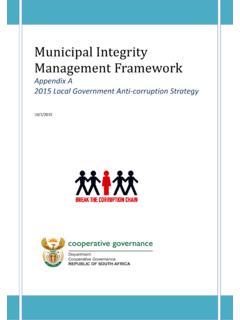
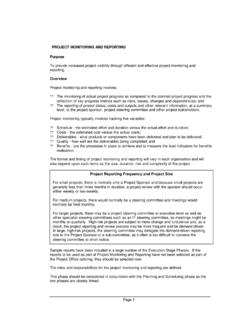
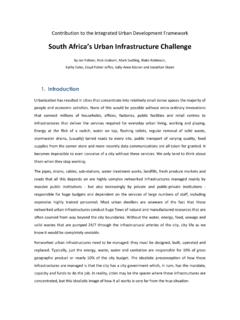
![Disaster Management Act [No. 57 of 2002]](/cache/preview/e/5/d/2/b/3/6/7/thumb-e5d2b36743b64ebe9204d7e874f734ad.jpg)
